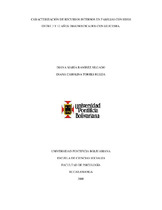| dc.contributor.advisor | Torres Serrano, Ricardo Andrés | |
| dc.contributor.author | Ramírez Silgado, Diana María | |
| dc.contributor.author | Torres Rueda, Diana Carolina | |
| dc.coverage.spatial | Seccional Bucaramanga. Universidad Pontificia Bolivarana. Escuela de Ciencias Sociales. Facultad de Psicología | spa |
| dc.coverage.temporal | 2008 | |
| dc.date.accessioned | 2013-06-21T19:23:24Z | |
| dc.date.available | 2013-06-21T19:23:24Z | |
| dc.date.issued | 2013-06-21 | |
| dc.identifier.uri | http://hdl.handle.net/20.500.11912/230 | |
| dc.description | 192p.: (pdf); il; tablas; anexos | spa |
| dc.description.abstract | El cáncer infantil es una de las más grandes y notorias problemáticas del sector de la salud, no sólo a nivel nacional y regional, sino a escala mundial, afectando al menos a 160.000 niños en el mundo cada año y convirtiéndose en la segunda causa más importante de mortalidad infantil. En esta población, la Leucemia constituye el tipo de cáncer más común y su presencia en un núcleo familiar genera una serie de cambios a nivel psicológico que reestructura relaciones familiares, lo cual puede llegar a convertirse en un evento reforzante o estimulante de ciertos recursos internos. Teniendo en cuenta lo anterior, surge este proyecto de investigación que tiene como objetivo identificar los recursos internos en una muestra de la población de 10 familias con hij@s diagnosticados con leucemia, con edades comprendidas entre los 3 y 12 años de edad, con un tiempo de diagnóstico superior a un año y vinculados al AVAC de la ciudad de Bucaramanga. Con respecto a la metodología utilizada, esta investigación se realizó a nivel ExploratorioDescriptivo, con un diseño No Experimental de Corte Transversal; para obtener la información se usó una Entrevista Semiestructurada. A nivel general, se encontró que el principal recurso interno utilizado por las familias es la Adaptabilidad, seguido de la Cohesión, la Comunicación, los Rituales Familiares y el Orgullo Familiar. Sin embargo, todos ellos lograron evaluarse tanto antes como después del diagnóstico de la enfermedad del niñ@ en los diez sistemas familiares participantes, observándose un fortalecimiento de ellos como consecuencia del diagnóstico y facilitando la adaptación a la enfermedad y a los eventos estresores que vivenciaron las familias como producto de éste. De esta manera, se concluyó cómo la promoción de estos recursos en los sistemas familiares se convierte en un elemento fundamental a la hora de generar nuevos programas de intervención. | spa |
| dc.description.abstract | The cancer in children is one of the biggest and notorious problematics of the health field, not only at the national and regional level, but in a world scale, affecting at least 160.000 children in the world each year and becoming the second more important cause of child mortality. In this population, the leukemia constitutes the most common type of cancer and its presence in the family nucleus generates a series of changes to a psychological level, this could become to convert in a reforcing or stimulating event of certain internal resources which allows families a better adaptation to the diseases diagnosis. According to this, the research project has as objective to determine the internal resources in a sample of 10 families with children between 3 and 12 years old with leukemia diagnosis with a time of diagnosis more than one year and linked to the AVAC of the city of Bucaramanga. Regarding to the methodology used, this research was developed at a ExploratoryDescriptive level, with a Not Experimental design crosssectional to obtain the information was used a semistructured interview aimed at families with children between 3 and 12 years diagnosed with leukemia. At the general level, was founded the adaptability as the principal internal resource used by the families, followed by the cohesion, the communication, the family rituals and the family proud. However, all of them were evaluated both before and after the diagnosis of the disease of children in the ten participating family systems, with a strengthening of them as a result of the diagnosis and facilitating adaptation to illness and the stressing events which were lived by the families. In this way, it was conclude the promotion of these resources in the family systems becomes a fundamental element at the time of generate new intervention programs. | spa |
| dc.language.iso | es | |
| dc.publisher | Universidad Pontificia Bolivariana | spa |
| dc.rights | Attribution-NonCommercial-NoDerivatives 4.0 International | * |
| dc.rights.uri | http://creativecommons.org/licenses/by-nc-nd/4.0/ | * |
| dc.subject | Tesis y disertaciones académicas | spa |
| dc.subject | Familia paciente - aspectos psciológicos | spa |
| dc.subject | Leucemia en niños - experiencia de los padres | spa |
| dc.subject | Niños Enfermedades - aspectos psicológicos | spa |
| dc.subject | Psicología infantil | spa |
| dc.subject | Mente y cuerpo | spa |
| dc.subject | Trabajos de grado psicología | spa |
| dc.title | Caracterización de recursos internos en familias con hijos entre 3 y 12 años diagnosticados con leucemia | spa |
| dc.type | bacherlorThesis | spa |
| dc.rights.accessRights | openAccess | spa |
| dc.type.hasVersion | publishedVersion | spa |
| dc.identifier.instname | instname:Universidad Pontificia Bolivariana | spa |
| dc.identifier.reponame | reponame:Repositorio Institucional de la Universidad Pontificia Bolivariana | spa |
| dc.identifier.repourl | repourl:https://repository.unab.edu.co/ | |


